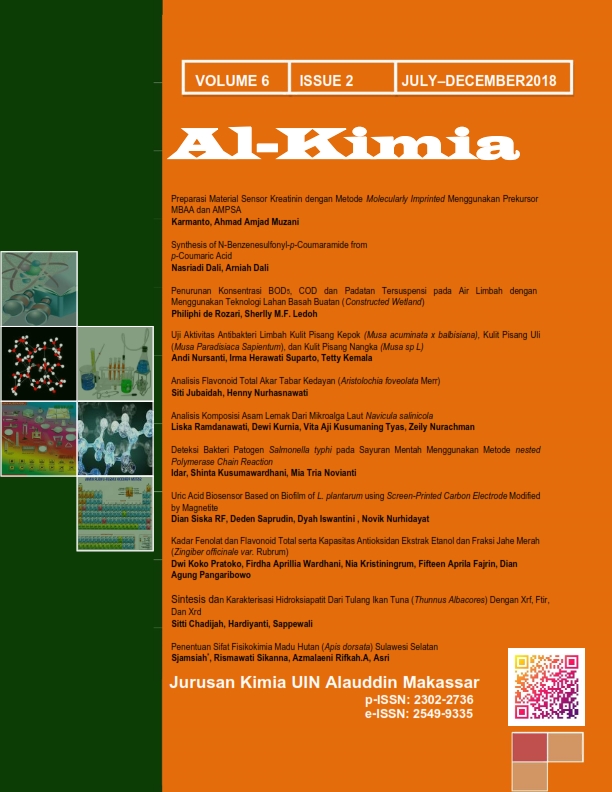Uric Acid Biosensor Based on Biofilm of L. plantarum using Screen-Printed Carbon Electrode Modified by Magnetite
Abstract
Biosensor based on biofilm of L. plantarum has been successfully done for determination of uric acid in human urine compared with colorimetric enzymatic produced relative error of less than 5%. L. plantarum has uricase activity to react with uric acid, to maintain the stability of bacteria forming themselves into biofilms. Magnetite is known to increase sensitivity of the biosensor. The combination of magnetite-polyethylene glycol (Fe3O4-PEG) was used to modify the surface of Screen-Printed Carbon Electrode modified (SPCE) and the resulting modified electrode (biofilm/Fe3O4/PEG/SPCE) displayed good electrocatalytic activity to the oxidation of UA. The composition of biofilms with optical density 1, magnetite 100 mgmL-1 and PEG 3% v / v were able to increase the current up to 48% in 4mM of UA. The biosensor with an optimum composition produced good linearity with a concentration range, limit of detection, limit of quantitation, sensitivity, and repeatability were found to be 0.1 - 4.3 mM, 70 µM, 234 µM, 25.392 µA mM-1, 2.38%, respectively. This biosensor stable up to 49 days of measurement with the remaining activity was 90.70% and selective for interference compounds such as salt, urea, glucose, ascorbic acid. This method has a good stability, sensitivity, and potential application in clinical analysis.
Downloads
References
Anderson, A., Vijayakumar, S. (2011). Purification and optimization of uricase enzyme produced by Pseudomonas aeruginosa. Journal of Experimental Sciences, 2(11), 5-8.
AOAC. (2011). Guidance for standard method performance requirements. United state (US): AOAC International, 1-27.
Aoudia, N., Rieu, A., Briandet, R., Deschamps, J., Chluba, J., Jego, G., Garrido, C., Guzzo, J. (2015). Biofilms of Lactobacillus plantarum and Lactobacillus fermentum: effect on stress responses, antagonistic effects on pathogen growth and immunomodulatory properties. Food Microbiology, doi: 10.1016/j.fm.2015.04.009.
Atalla, M. M., Farag, M. M., Eman, R. H., Abd-El-Lataif, M. S., Nehad, E. A. (2009). Optimum conditions for uricase enzyme production by Gliomastix gueg. Malaysian Journal of Microbiology, 5(1) : 45–50.
Chaudhari, R. D., Joshi, A. B., Srivastava, R. (2012). Uric acid biosensor based on chemiluminescence detection using a nano-micro hybrid matrix. Sensors and Actuators B. Chemical. 173 :, 882–889, doi: 10.1016/j.snb.2012.08.001.
Cheng, W., Tang, K., Qi, Y., Sheng, J., Liu, Z. (2010). One-step synthesis of superparamagnetic monodisperse porous Fe3O4 hollow and core-shell spheres. Journal of Materials Chemistry, 20, 1799–1805. doi: 10.1039/b919164j.
Donlan, R. M., Conserton, J. W. (2002). Biofilms: Survival mechanisms of clinically relevant microorganisms. Clinical Microbiology Reviews, 15(2), 167-189, doi: 10.1128/CMR.15.2.167–193.2002.
Govindasamy, M., Mani, V., Chen, S., Sathiyan, A. (2016). Sensitive and selective determination of uric acid using polyaniline and iron composite film modified electrode. International Journal of Electrochemical Science. 11 : 8730–8737.
Honeychurch, K. C. (2017). The determination of uric acid in human saliva by liquid chromatography with electrochemical detection. Journal of Analytical, Bioanalytical and Separation Techniques, 2(1) : 1–5.
Iswantini, D., Nurhidayat, N., Trivadila, Mardiah, E. (2009). Aktivitas urikase yang dihasilkan dari berbagai sel Lactobacillus plantarum dan parameter kinetikanya. Jurnal Ilmu Pertanian Indonesia, 14(3) : 163–169.
Iswantini, D., Rachmatia, R., Diana, N. R., Nurhidayat, N., Akhiruddin, Saprudin, D. (2016). Activity and stability of biofilm uricase of Lactobacillus plantarum for uric acid biosensor. IOP Confference Series: Earth and Evironmental Sciences, 31, doi:10.1088/1755-1315/31/1/012028.
Junejo, Y., Baykal, A., Sozeri, H. (2013). Simple hydrothermal synthesis of Fe3O4-PEG nanocomposite. Central European Journal of Chemistry, 11(9) : 1527-1532, doi: 10.2478/s11532-013-0281-9.
Maunatin, A., Khanifa. (2012). Uji potensi probiotik Lactobacillus plantarium secara in-vitro. Alchemy, 2(1) : 26–34.
Copyright (c) 2018 Dian Siska Rahma Fatonah, Deden Saprudin, Dyah Iswantini, Novik Nurhidayat

This work is licensed under a Creative Commons Attribution-NonCommercial-ShareAlike 4.0 International License.
Authors who publish with this journal agree to the following terms:
1) Authors retain copyright and grant the journal right of first publication with the work simultaneously licensed under a Creative Commons Attribution License that allows others to share the work with an acknowledgement of the work's authorship and initial publication in this journal.
2) Authors are able to enter into separate, additional contractual arrangements for the non-exclusive distribution of the journal's published version of the work (e.g., post it to an institutional repository or publish it in a book), with an acknowledgement of its initial publication in this journal.
3)Authors are permitted and encouraged to post their work online (e.g., in institutional repositories or on their website) prior to and during the submission process, as it can lead to productive exchanges, as well as earlier and greater citation of published work (See The Effect of Open Access).


